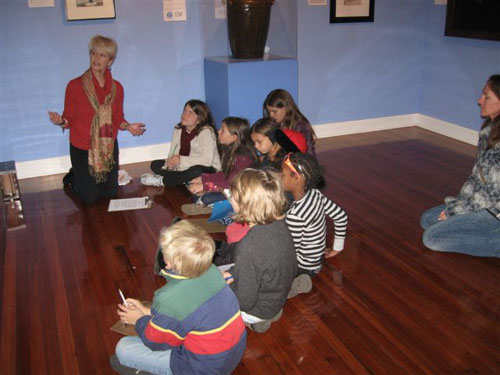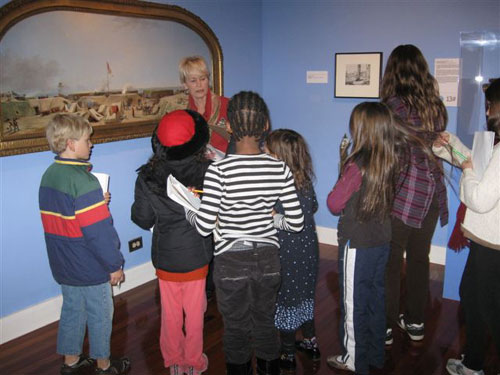The Montessori Day School is taking advantage of our guided school tours in a unique way. This group of students, ages six to twelve years old, is working with Museum Educator Elise Detterbeck in the galleries once a month during the school year. Rebecca Sailor, Associate Curator of Education, has had the opportunity to observe the students as they interact with and learn from Elise. After the school’s most recent visit, Rebecca talked with Elise about the curriculum. Their conversation is below.
Rebecca Sailor: There are so many approaches when working with kids in the galleries. What have you focused on with the Montessori School group?
Elise Detterbeck: I have chosen to organize the visits by looking at different genres of painting each visit. During their first visit, in October, we explored portraits (both miniature and full size), and talked about traditional versus modern (pose, attributes, props) and how they reflect the culture of the time in which they are painted. The Face Lift exhibition provided a great resource for exploring this theme.
In November, we focused on landscapes, once again starting with traditional and ending with modern. This time we talked about composition (background, foreground, midground and the horizon line), texture, point of view (bird’s eye, worm’s eye, Dutch angle, straight-on), as well as style (realistic, impressionistic, abstract), and subject matter.
This last visit, we talked about genre pictures (pictures that tell a story). This style of painting allowed us to revisit and review what we had discussed in visits one and two, since many genre scenes have the same elements as portraits and landscapes. In addition to the discussion, I gave the children a writing project based on one of our paintings.
As for the last three visits, I am discussing plans with the teachers. These children are extremely bright, really enthusiastic, and full of energy. What a joy! I’m thinking we should do some kind of hands-on activity with them to really cement what we’ve learned. One idea is to have them create an activity book starting with December’s writing activity, which they can add to each visit. I do want to encourage them to experiment with their own styles of drawing. They draw outside while waiting to come into the museum, so I think they would enjoy it.

Rebecca Sailor: What do you hope to accomplish with this class?
Elise Detterbeck: This is a wonderful opportunity to introduce students to the art of looking. My first question is always “What do you see?” These kids are so into it that they don’t even wait for me to ask the question anymore. My ultimate goal is to teach them how to look at a work of art and be able to understand it on multiple levels. For example, what is the creator trying to express, and how does the work reflect the artist and his or her view of the world? I also want the students to explore the possibilities of what the piece means to themselves, and how it relates to their own world view.
Rebecca Sailor: What do you feel are the benefits of monthly visits?
Elise Detterbeck: I worked in Chicago at the Terra Museum and we had some schools that came three times in a school year, but every month is even better. Multiple visits, with a small group like this, are so good because you can lay the foundation and then build on it, thus adding more and more each time you see them. And the joy of this Montessori group is that they remember so much between visits.
Rebecca Sailor: As their leader, what do you envision being your favorite part?
Elise Detterbeck: My favorite part is definitely the “ah-ha!” moment, when they use the looking strategies to figure out a work of art. They see things I’ve never seen, even after working with a piece so many times.
Rebecca Sailor: Is there anything else you want to say about your experience with the Montessori School?
Elise Detterbeck: I think my challenge is going to be to make each visit unique in its own way, and valuable to each student. That is why I want them to create something themselves, which will personalize the experience for every individual.
—Rebecca Sailor, Associate Curator of Education, Gibbes Museum of Art
Published December 22, 2010


